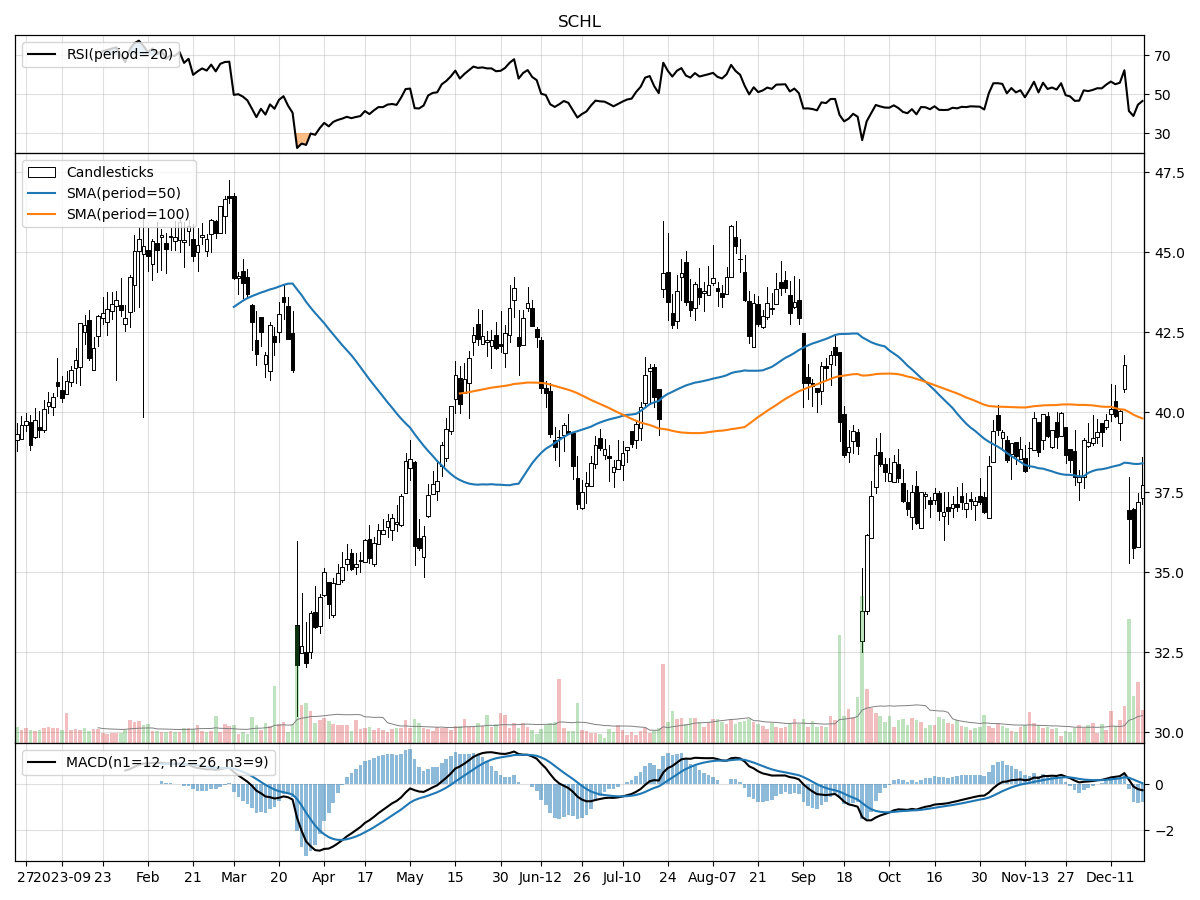Scholastic Corporation (SCHL), Mid/Small Cap AI Study of the Week
Despite a 4% decrease in revenues, Scholastic Corporation has demonstrated an admirable ability to increase its earnings, with net income per diluted share climbing to $2.45. This growth is particularly notable in the context of a challenging economic environment...

December 21th, 2023
Weekly AI Pick from the S&P 400 or S&P 600
Scholastic Corporation (SCHL)
Company Overview
Scholastic Corporation is a leading global children's publishing, education, and media company, operating through three primary segments: Children's Book Publishing and Distribution, Education Solutions, and International. The company is recognized for its significant contributions to children's literacy and education, with a broad range of products including books, educational materials, and media content. In fiscal years 2021 to 2023, Scholastic's revenues saw growth, reaching $1.704 billion in the latest fiscal year, with the Children's Book Publishing and Distribution segment contributing the majority of the revenue at 60.9%.
The company's diverse channels for distribution encompass school book clubs, book fairs, retail, and online platforms, with a particularly strong online presence. Scholastic's notable book series such as Harry Potter and The Hunger Games are part of their Children’s Book Publishing and Distribution segment. Additionally, Scholastic has expanded into media, developing content like "Eva the Owlet" for AppleTV+. The Education Solutions segment, responsible for 22.7% of revenues, focuses on providing comprehensive literacy materials and services to educational institutions. Internationally, Scholastic operates in several key markets, including Canada, the UK, and Asia, accounting for 16.4% of the company's revenues.
Scholastic relies on third-party manufacturing contracts, with a primary distribution hub in Jefferson City, Missouri. The company's revenue generation is subject to seasonality, peaking during the school year's second and fourth fiscal quarters. Scholastic competes in a challenging market with both established firms and new entrants, emphasizing the importance of intellectual property rights and sustainable business practices.
With around 6,760 employees as of May 2023, Scholastic values diversity and inclusion, reflected in their product offerings and workplace culture. The company maintains a comprehensive compensation and benefits structure, including health plans, retirement plans, and stock purchase options. Executive officers and financial reports are available through Scholastic's Investor Relations, providing transparency and insight into the company's operations and financial health.
By the Numbers
Annual 10-K Report Summary:
- Revenue increase of 3.7%, reaching $1,704.0 million.
- Children's Book Publishing and Distribution segment revenue up by 29%.
- Education Solutions segment revenue declined.
- International revenue increased in Major Markets (local currencies).
- Operating income improved by $8.9 million to $106.3 million.
- One percentage point change in obsolescence reserve rate could impact operating income by $4.2 million.
- Children's Book Publishing and Distribution revenues increased by $91.5 million.
- Education Solutions and International segments decreased by $7.0 million and $23.4 million, respectively.
- Cost of goods sold improved slightly to 46.2% of revenue.
- Selling, general, and administrative expenses rose by $33.8 million.
- Net income increased to $86.5 million.
- Basic and diluted income per share increased year-over-year.
- Trade channel revenues declined by $23.3 million.
- Operating income increased to $143.4 million.
- Education Solutions segment's revenue fell to $386.6 million, a 1.8% decline.
- International revenue decreased by 7.7%; operating loss of $3.6 million.
- Cash from operating activities decreased by $77.1 million.
- Cash used in investing activities rose by $56.4 million.
- Cash used by financing activities decreased to $139.5 million.
Quarterly 10-Q Report Summary:
- Revenues decreased by 4%, to $562.6 million.
- Net income per diluted share increased from $2.12 to $2.45.
- Children's Book Publishing and Distribution segment's revenues fell.
- Education Solutions segment remained stable.
- International segment had mixed results.
- Net income for the quarter increased to $76.9 million.
- Earnings per share for the quarter: $2.51 (basic), $2.45 (diluted).
- Six-month net income decreased by $27.1 million to $2.7 million.
- Earnings per share for six months: $0.09 (basic and diluted).
- International segment's revenues decreased by $3.1 million to $86.5 million for the quarter.
- Operating income for the International segment improved by $1.3 million to $8.0 million.
- Domestic segment's cost of goods sold increased as a percentage of revenues.
- Operating income for the domestic segment decreased by $1.2 million for the quarter.
- Unallocated overhead expenses decreased by $3.5 million for the quarter.
- Cash flow from operating activities rose by $50.3 million to $71.6 million for six months.
- Cash used in investing activities increased by $3.3 million to $49.1 million.
- Financing activities used $97.8 million, an increase of $68.8 million.
- Cash and cash equivalents were at $149.5 million.
- Authorized increase for common stock repurchases by $100 million.
- No outstanding borrowings under the U.S. credit agreement as of November 30, 2023.
Stock Performance and Technical Analysis

Based on the technical indicators provided, the stock in question is trading somewhat neutrally with a slight bullish bias. The current stock price is situated comfortably above the 52-week low by 17%, indicating that the stock has maintained a level of support and has not revisited its lowest valuation over the past year. However, being 19% below its 52-week high suggests that the stock is currently off-peak and could potentially have room to grow if it moves towards retesting its previous highs.
Trading volume is an important indicator of liquidity and investor interest. The recent daily volume is higher than the longer-term average, suggesting increased trading activity. While this could sometimes imply heightened interest due to either positive developments for the company or speculative trading, the relatively stable price over the last month and three months indicates that despite increased volume, the price has not experienced significant volatility. This could mean that the market is absorbing the additional volume without major price changes, possibly due to a balanced level of supply and demand.
The Money Flow Index (MFI) and the Relative Strength Index (RSI) are momentum indicators that provide insights into the buying and selling pressure. The stock being under moderate buying pressure and not being overbought or oversold (according to RSI) suggests that there is a healthy interest in the stock without it reaching extremes that often precede reversals. Accumulation, as indicated by money flow indicators, demonstrates that investors are potentially buying the stock in anticipation of future price increases. The Moving Average Convergence Divergence (MACD) being bullish (positive value) indicates that the short-term momentum is stronger than the long-term momentum, reinforcing the potential for continued upward price movement.
In conclusion, the technical analysis suggests that the stock is currently experiencing moderate buying interest, indicated by positive money flow and a bullish MACD, without being overextended according to RSI. The stable price trend despite increased volume hints at a market agreement on price, but the distance from the 52-week high suggests there may be potential for upside. As always, it's important to consider these indicators in conjunction with fundamental analysis of the company and broader market conditions before making any investment decisions.

The ‘Bull’ Perspective
Investing in Scholastic Corporation: A Strategic Play in Children's Publishing and Education
Summary:
- Robust Earnings Growth: Scholastic Corporation reported a significant increase in net income per diluted share, rising from $2.12 to $2.45 in the latest quarter, showcasing its ability to grow earnings amidst challenging market conditions.
- Operational Efficiency Gains: The company has effectively managed to reduce costs in key areas such as printing, freight, and royalty costs, which could lead to improved margins in the long term.
- Strategic Positioning in Education: With stable revenues from its Education Solutions segment and growth in book fairs, Scholastic is well-positioned to capitalize on the need for educational resources as schools continue to normalize post-pandemic.
- Strong Cash Flow Generation: A significant increase in cash flow from operating activities to $71.6 million highlights the company's solid financial management and operational efficiency.
- Shareholder Value Initiatives: Scholastic's authorization for an additional $100 million in common stock repurchases reflects a commitment to enhancing shareholder value and confidence in its financial stability.
Elaboration:
- Robust Earnings Growth:
Despite a 4% decrease in revenues, Scholastic Corporation has demonstrated an admirable ability to increase its earnings, with net income per diluted share climbing to $2.45. This growth is particularly notable in the context of a challenging economic environment where many businesses are struggling to maintain profitability. The company's focus on cost efficiencies and the strategic growth of its book fair segment, which is nearing pre-pandemic levels, are likely contributors to this positive outcome. These numbers indicate Scholastic's potential for continued earnings growth as market conditions stabilize. - Operational Efficiency Gains:
Scholastic's ability to reduce costs in critical areas such as printing, freight, and royalty costs is a testament to its operational prowess. These efficiencies have helped offset other rising expenses and investments in facilities and labor. This disciplined approach to cost management is essential for maintaining profitability, especially when facing revenue headwinds. As the company continues to streamline its operations and optimize its cost structure, it is likely to see improvements in its margins, which will be beneficial for long-term financial health. - Strategic Positioning in Education:
The Education Solutions segment's stability is a cornerstone of Scholastic's business strategy. With steady revenues and the growth of book fairs, the company is tapping into the ongoing demand for educational content and resources. As schools return to more traditional learning environments, Scholastic's offerings in literacy and education are poised to meet the needs of educators, parents, and students alike. This strategic positioning within the education sector provides a stable revenue stream and opportunities for expansion as educational practices evolve. - Strong Cash Flow Generation:
Scholastic's impressive cash flow from operating activities, which rose to $71.6 million, underscores the company's financial acumen. With $80 million less spent on inventory purchases, Scholastic has demonstrated a keen focus on capital management and operational efficiency. Strong cash flow is a critical indicator of a company's ability to sustain operations, invest in growth, and navigate economic cycles, making Scholastic an attractive investment for those looking for financial stability and prudent management. - Shareholder Value Initiatives:
The authorization of an additional $100 million for stock repurchases signals Scholastic's commitment to returning value to shareholders. This move suggests that the company is confident in its financial position and future prospects. Moreover, stock repurchases can often lead to an increase in earnings per share and provide support for the stock price, both of which are beneficial for current investors. Such shareholder-friendly actions reflect positively on the company's governance and its focus on long-term value creation.
Conclusion:
In light of the recent financial performance, cost management strategies, and strategic initiatives, Scholastic Corporation presents a compelling investment opportunity. While the company faces risks such as changing customer preferences, competition, and regulatory compliance, its strong earnings growth, operational efficiencies, strategic market positioning, robust cash flow, and shareholder value initiatives paint a picture of a resilient company with potential for growth. Investors should consider these factors when evaluating Scholastic as a potential addition to their portfolios.

The ‘Bear’ Perspective
Scholastic Corporation: Why Investors Should Steer Clear
Upfront Summary:
- Declining Revenues: Scholastic Corporation has reported a 4% decrease in revenues year-over-year, with a significant $47.4 million drop over a six-month period.
- Segment Weakness: The Children's Book Publishing and Distribution segment, a core area of Scholastic's business, has seen lower book club sales and media revenues.
- Operational Cost Pressures: Rising operational costs, particularly in selling, general, and administrative expenses, are eroding profit margins.
- Market and Technological Risks: Scholastic's transition to digital and print literacy solutions is a strategic risk, requiring substantial investment in a rapidly changing market.
- Regulatory and Compliance Vulnerabilities: Compliance with data privacy laws, intellectual property rights management, and international regulations presents ongoing risks.
Elaboration on Points:
- Declining Revenues:
Scholastic Corporation's recent financial reports have raised red flags for investors, with a notable 4% decline in revenues, amounting to $562.6 million. Over a six-month period, this downturn is even more pronounced, with a $47.4 million revenue drop. Such figures suggest a concerning trend that could signal deeper issues within the company's business model or market position. Given that net income also saw a dramatic decrease by $27.1 million to just $2.7 million over the same period, investors should question the sustainability of Scholastic's profitability in the face of these declining revenues. - Segment Weakness:
The Children's Book Publishing and Distribution segment is experiencing troubling headwinds, with falling book club sales and media revenues. While book fairs have shown growth, it's not enough to counterbalance the declines, which could be indicative of broader shifts in consumer behavior and educational spending. With this segment being a cornerstone of Scholastic's operations, a downturn here could have ripple effects across the company, potentially leading to further revenue erosion and market share loss. - Operational Cost Pressures:
Scholastic's operational costs are on the rise, particularly in the realm of selling, general, and administrative expenses. These increased expenditures, which reflect investments in facilities and labor, are offsetting cost savings achieved in the cost of goods sold. With the cost of goods sold increasing as a percentage of revenues in the domestic segment, and operating income decreasing by $1.2 million for the quarter, Scholastic's financial health appears to be under considerable strain. - Market and Technological Risks:
As Scholastic pivots towards digital and print literacy solutions, it faces significant strategic risks. The company is investing heavily in this transition, but there is no guarantee of profitable returns, especially given the rapid technological changes and stiff competition in the publishing and education markets. Scholastic's ability to anticipate and adapt to these trends is crucial, yet the company's recent performance raises questions about its capacity to do so effectively. - Regulatory and Compliance Vulnerabilities:
Scholastic must navigate a complex web of data privacy laws, intellectual property rights, and international regulations. Compliance with laws such as GDPR and CCPA is non-negotiable, and any missteps could lead to hefty penalties, reputational damage, and loss of business. Additionally, the company's global operations amplify these risks, with varying international laws further complicating compliance efforts. The decentralized nature of Scholastic's operations poses additional challenges in ensuring consistent adherence to ethical and legal standards.
Conclusion:
Given the combination of declining revenues, segment weakness, operational cost pressures, market and technological risks, and regulatory and compliance vulnerabilities, Scholastic Corporation presents a precarious investment proposition. While the company has been a longstanding player in the educational publishing space, current financial and operational challenges, compounded by external market and regulatory risks, suggest a bearish outlook. Prudent investors may want to consider these factors carefully before making any investment decisions regarding Scholastic Corporation.




Comments ()